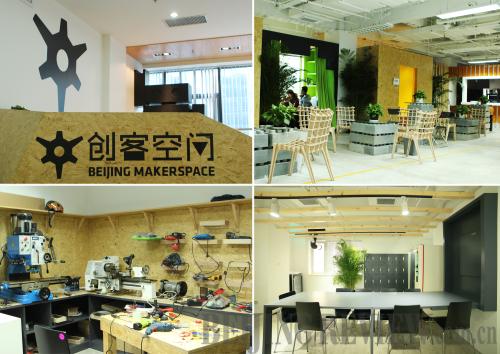|
 |
|
BEIJING MAKERSPACE: The lab boasts a new-age design to inspire new inventions (MA PING) |
With electric drills, laser cutting machines, sandpaper and circuit boards scattered around, Beijing Makerspace, located in Zhongguancun International Digital Design Center, could be mistaken for a typical engineering workshop.
Yet, it differs from a regular workshop in that it is a laboratory where people can share resources and creative ideas and build things together.
The lab's mission is to develop open-source hardware and encourage innovation. Here people share knowledge so that anyone can build on what somebody else has done, which is expected to facilitate innovation.
"Once you get an idea, you can come to the Makerspace and make it true," said Wang Shenglin, the lab's founder, "Because it's a lab for anyone who has a dream."
Interesting gadgets
Founded in 2011, the lab has given birth to some interesting objects, including a spider robot made by Cheng Cheng, a hardware engineer in Beijing and a frequent visitor to the lab.
The spider robot can be remotely controlled by a cellphone application. Pressing the direction keys displayed on a cellphone screen, one can order the spider to advance, back, and turn around. Pressing a "shoot" key, one can command the spider to unleash a hail of plastic bullets.
Cheng credited his success to open-source plans and schematics shared by other makers online. To make the spider robot, he first bought an assembled toy spider, and then installed a motor and a control board that can manipulate the robot through Bluetooth technology.
At Makerspace, one does not have to be a guru in software programming or circuit design to produce a device, Wang said.
Makers can work in teams so that they are able to stand on each other's shoulders, said Wang. "Visitors to Makerspace include college students, designers, engineers and other professionals. Regardless of one's professional background you can come here with your ideas," he said.
Once, a team of about 10 persons including software programmers, engineers and fashion designers came together in Beijing Makerspace at a weekend for a Hackathon program. The program required them to create something within 48 hours. After brainstorming, they decided to make a musical T-shirt.
Their initial design was to record sound waves into the computer, and print the pattern onto a T-shirt. After experiments, they found that a sound lasting for one second would produce a 1-meter-long pattern. A T-shirt was not big enough to record meaningful music.
Then they altered their design, writing a computer program to translate colors on a T-shirt into musical notes. They scanned colored bars on the T-shirt, and heard music. It was a success.
The Makerspace is more than a fun place for DIY lovers. Some of the devices made by makers there have commercial value.
A device made by Wang Bolong, a member of the Makerspace, to gauge audience reactions to rock-and-roll performances have been installed in several bars in Beijing.
When he first came to Makerspace, he was a postgraduate student majoring in precise instrument in Beijing University of Aeronautics and Astronautics and the lead singer of a rock band.
At the band, he found that excited audience members tend to get involved in the performance and move to the song's rhythm. He hit upon an idea to produce a "sensing" floor that can visualize audience's excitement and project it onto a screen. At Beijing Makerspace, Wang Bolong delivered his brainchild into the real world. His project attracted attention and investment from investors.
| 